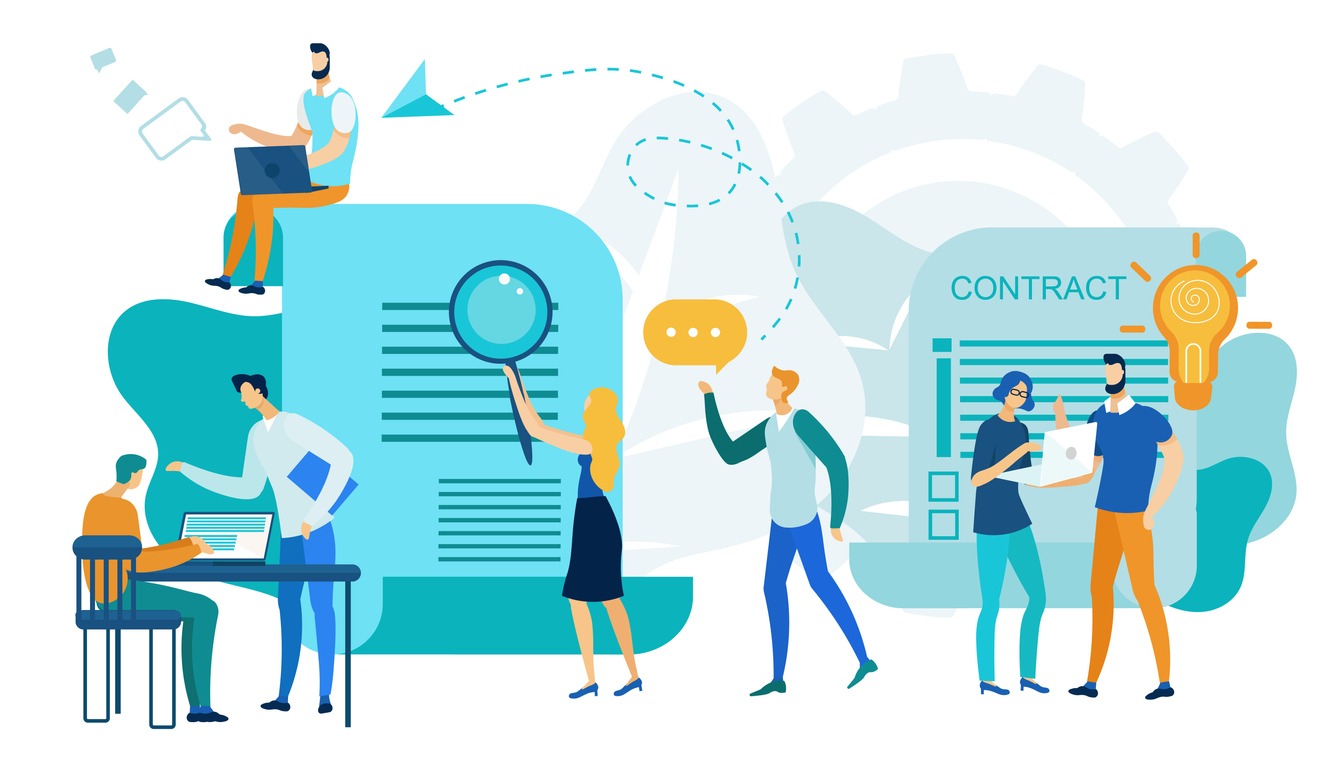A SaaS contract is a legal document that consists of different individual elements. All that technical jargon can be too much for some to understand, especially for those who have never encountered one in the past. Things become clearer once you start breaking it down into smaller parts. A SaaS contract governs the relationship between the customer and the vendor, and outlines the terms and conditions under which the vendor will provide services.
That’s why it’s so important to understand what it says and means. This post focuses on some important considerations when negotiating a SaaS contract, but let’s start with what a SaaS contract encompasses and its importance.
What is a SaaS Contract?
Unlike most traditional licenses that involve a one-time payment, SaaS solutions are offered on a subscription basis with different pricing tiers. Because of being a subscription model, a SaaS contract is different from a standard software licensing model. A SaaS contract defines the rights of the customer and obligations of the vendor, software access during the subscription period, and covers different aspects including the following:
1. The number of users who can access the software
2. Who owns the data?
3. Warranties (how a service will be delivered, performance objectives, guaranteed uptime and performance)
4. Pricing, payment schedule, subscription tiers
5. Data security responsibilities (who is responsible for security, data backup, etc.)
6. License scope (rights and limits of the customer)
7. Limitation of liability (liabilities the vendor will accept or deny)
8. Renewal, subscription period, upgrade/downgrade, cancellation, changing and penalties
In addition to SaaS agreements, companies can also engage in other agreements, including:
Company level: Non-disclosure or confidentiality, IP transfer or assignment, employment, and shareholder agreements
Customer-facing: Master services agreement, sales order and purchase, service-level and terms or use/service agreements
Public-facing: Privacy, trademark and security policies
Third-party: Affiliate, contractor and advisor agreements
SaaS Contract Lifecycle
The SaaS contract lifecycle starts with procurement, which involves choosing the most suitable vendor by striking the right balance between budget, business needs and what’s on offer. Procurement is followed by contract negotiation and agreement signing, which helps identify important terms and conditions. The next stage is the implementation stage in which the SaaS solution is deployed and integrated with other solutions, and training is carried out.
Renewal is the fourth stage in which the user re-evaluates the contract, its own needs, and renews the subscription before expiration of the existing contract. Termination is the last stage in which the customer terminates the contract and moves to another vendor, which can be the fourth and the final stage if a customer decides not to renew the contract.
The Importance of SaaS Contracts
SaaS contracts serve a similar purpose as other contracts i.e. to ensure accountability, clearly define expectations and limitations, and minimize the chances of future disputes and misunderstandings. The main reasons why you should understand and manage SaaS contracts include.
Provides Legal Cover
Being a legally binding agreement, a SaaS contract protects the interests and rights of both the customer and the vendor. Clearly defined responsibilities, liabilities and remedies provide legal protection in case of non-compliance or contract breach.
Provides Clarity and Establishes Expectations
By clearly defining the scope of services and deliverables, including what functionalities and features are included as well as limitations, SaaS contracts establish what to expect from the vendor. This minimizes the risk of disputes or misunderstandings in the future.
Mitigates Risk
Cloud computing comes with its own risks, including data security, intellectual property rights and privacy concerns. SaaS contracts include specific provisions for these areas, which helps in mitigating risks associated with using SaaS software, ensures compliance with industry regulations, and protects sensitive data and intellectual property.
Pricing and Payments
SaaS contracts explain subscriptions fees, additional costs, billing cycles and clearly define pricing and payment terms. This ensures transparency regarding pricing and customers’ financial commitment as well as protects the vendor and makes sure that they are adequately compensated for their services.
Defines Performance Standards and Guarantees
SLAs (Service Level Agreements) are part of SaaS contracts and focus on the software services guarantees and performance standards. An SLA includes key performance indicators including uptime guarantee, response times and commitments related to customer support and services. An SLA is an integral part of a SaaS contract and gives customers a recourse if the vendor is not fulfilling its obligations. Customers need to choose the SaaS provider carefully and make sure that the SLA clearly defines both the deliverables and liabilities.
Scalability
By providing specific provisions and addressing scalability and flexibility needs, SaaS contracts can accommodate seasonal changes and future growth. These provisions include adding more users or removing users, changing subscription level and customization options.
Key Elements of SaaS Contracts
SaaS contracts vary depending on the type of industry, services and customer types, but there are some key elements that should be included in SaaS contracts, including the following.
Service Description: The specifics of what the vendor will deliver, including functionalities, integration capabilities and features. May also specify if the customer has the right to a physical copy of the software.
SLA: Performance standards and guarantees, including uptime, response time, availability and customer support.
Pricing and Payment Terms: Outlines the pricing structure, billing cycle and other payment terms and conditions such as due dates, payment methods and late payment penalties.
Data Security: It is an important component to consider and specifies what measures will be taken to ensure security and availability of data. These measures include where the data is stored, encryption, data backup, data protection and remedies in case of a security breach, termination of services or bankruptcy.
Data Ownership: A SaaS contract should be crystal clear about who owns (and has the rights to) the data uploaded to servers of the service provider.
User and Access Rights: Defines a user, permitted number of users and penalty if that number is exceeded. Access can also be limited based on other factors including the amount of data.
Customer Support: Covers how support will be provided, what support channels will be used, response time and other customer support guarantees.
Intellectual Property Rights: Defines who owns and can use the intellectual property, including the software, customizations and other licensing terms, which helps protect the proprietary data of the customer and the vendor’s software.
Termination/Cancellation Policy: Clear termination policy is crucial for a smooth exit strategy and defines the conditions under which a party can cancel the contract and specifies the notice period, termination fees and procedures for data transfer and retrieval.
License Scope: A SaaS contract should be clear about who is the licensee (is it only the buyer or anyone who uses the software). The license scope also needs to be clearly defined, including possible limitations.
Key Considerations When Negotiating SaaS Contracts
Customers need to be aware of and avoid costly mistakes when signing up for a SaaS solution. Similarly, they also need to evaluate some important considerations when negotiating SaaS contracts. Failing to take these into account can impact the performance and value, and increases the risks usually associated with cloud computing services.
Evaluate Pricing and Payment Terms
Not all SaaS products are created equal and some cost more than others. However, price should not be the only deciding factor when choosing between different providers. Customers have to strike the right balance between cost and features. Still, price is one of the most important and more often than not, the deciding factor.
It’s important to understand and evaluate the pricing structure and other payment terms such as billing cycle, frequency and additional costs or discounts and match them with the available IT budget and expected usage. Some vendors explicitly avoid mentioning hidden or additional costs in the pricing terms, especially fees associated with customization, training and integration options.
It’s commonly believed that only enterprises and large businesses can negotiate pricing and contract terms. However, things have changed in the cloud computing world and SMBs should not hesitate to negotiate pricing and other contract terms, including warranties and customer support. It’s quite possible to acquire a software for less than what the vendor is asking for on its website.
Identify functionalities and features you need, available support options and other key aspects and evaluate pricing of similar solutions keeping these in mind. Skipping features and support options you don’t need can help negotiate a better deal. Similarly, negotiating for a multi-year contract can be more cost effective than going for a monthly payment term, especially when the product is useful for a long time period. Keep scalability in mind and consider including additional licenses for the future beforehand at a discounted rate.
Limitation of Liability
The clause allows vendors to minimize or even eliminate the risk associated with running a cloud-based software. A vendor offering unlimited liability is rare, so buyers need to carefully evaluate the limitation of liability clauses in a SaaS contract. The main purpose of the clause is to prevent buyers from using a product for non-compliant or illegal purposes, which can compromise software’s good standing. There should be a higher cap on damages such as data breach, and it’s better to consider legal advice when reviewing limitations of liability clauses.
Support
Support is not just limited to getting in touch with the vendor when something breaks. It also includes regular updates, security and maintenance. Some products heavily depend on great customer support, while others might not need much support. Businesses need to understand the level of support a vendor is providing and avoid paying for support channels they won’t be using. Paying less for limited support for a non-critical app might be a better financial decision than paying extra for white-glove 24/7 support.
Having a look at support metrics including FCR rate (First Contact Resolution), response time and asking existing users about the kind of support they are getting can give a fair idea of the type of support a vendor is providing. Mission-critical apps deserve dedicated support and account managers, and although not a cost-saving option, it can deliver higher value and a better ROI in the long term.
Warranty Policy
The warranty policy defines warranties that cover different instances including infringement and performance issues, and cybersecurity measures. Buyers need to make an effort to understand the included/excluded warranties before signing a contract as well as nuances such as liability of the vendor in case of a security breach.
Does the vendor offer a money-back guarantee or offer alternative remedies? What options are available if the buyers are unable to use the software to its fullest potential due to some reason? Questions like these can help evaluate the warranty policy and whether or not it aligns with business requirements and usage.
Start Negotiating for Renewals in Advance
Negotiations for SaaS contract renewals should start months in advance before the contract expires and much earlier for multi-year contracts. This is possible when you have not opted for auto-renewal, which compromises customer’s ability to negotiate renewal terms (unless you have secured a really good deal to begin with). Feedback from end users can be very helpful in this regard as they have a better know-how of the product, which can help the procurement team address their issues during the negotiation process.
Service Level Agreement, Service Description
The SLA is one of the most important parts of a SaaS contract. It defines the guaranteed uptime and availability (in percentage) as well as the compensation if the vendor falls short. The SLA should also clearly define the support response times and how to reach support, which should align with customers’ business needs and unique requirements.
The service description should align with business needs and include core functionalities and features, modules, integration capabilities and data compatibility. The service description usually also includes performance metrics and expectations, which include processing speeds, response times, and scalability.
Data Security, Ownership and IP Rights
The customer should have a good understanding of data retention policies and the rights to access, retrieve and delete data. Privacy and data protection regulations like CCPA and GDPR require vendors to comply with certain standards. Choose vendors that are compliant and evaluate security measures in place, their data handling practices and how they ensure data protection and privacy. Ask important questions including who owns modifications or customizations made in the software for your business, what are the rights and limitations around using, transferring, redistributing and sublicensing these customizations.
Conclusion
The growing popularity of SaaS apps and cloud computing also means businesses are accumulating more SaaS contracts than before. Failing to properly review and manage these contracts can translate into wasted spend, performance hiccups and slow-downs during the renewal process. From procurement to contract negotiation, implementation and renewal, businesses need to align their business objectives with the contract terms, which requires homework and careful consideration of the important aspects as covered before.
A big chunk of SaaS spend is usually wasted due to improper license management, while many businesses are unable to keep track of contracts. Having a close look at the fine print of a SaaS contract can help businesses save themselves from a lot of hassle down the road, optimize their IT spending, and protect their data, IP and rights as a customer.






